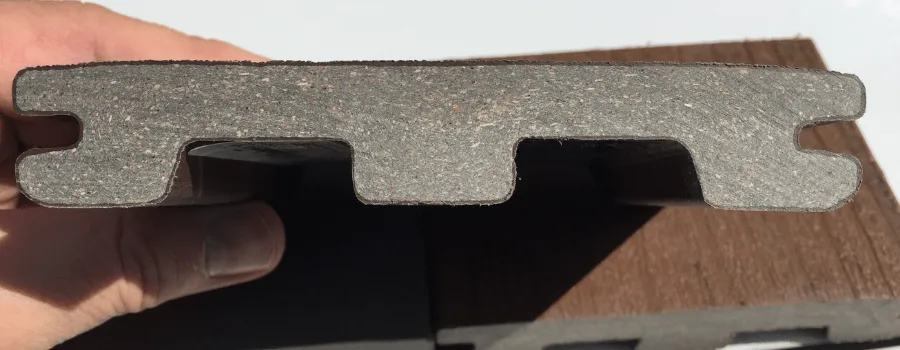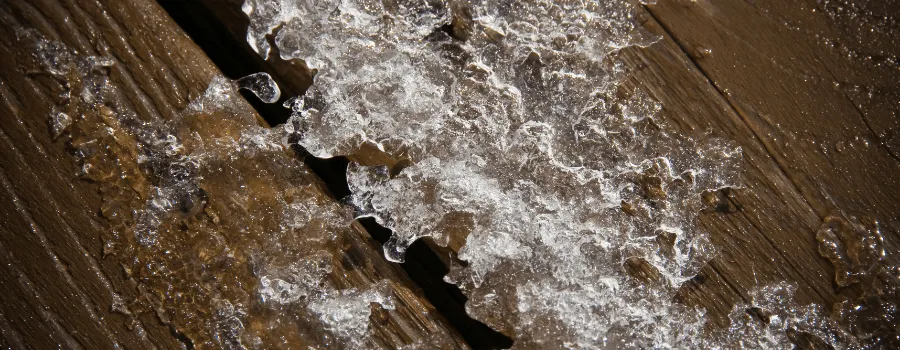You want a composite deck but don’t live in a hot spot like Arizona but rather a colder climate like Canada. Yes, we enjoy decks in Canada, where I live and build decks. There are a few considerations in choosing composite decking in cold climates.
The best composite decking for cold climates has minimal expansion and contraction, is fully protected against moisture from snowmelt. It is durable enough not to be damaged from regular shovelling of snow but providing traction for boots. A deck board that reflects heat and warms up to counteract the frigid temperature.
Just because you live where there are more winter days than summer does not mean you do not want to enjoy being outdoors. Like Calgary, even though we are considered a cold, northern city. Especially if you talk with somebody south of the border, we still have many days of sun.
In fact, on average, Calgary has 333 sunny days a year. That’s a lot of days out on the deck. Even in the middle of winter, a well-designed deck can be a pleasant escape from the indoors. Catching a few sun rays even with snow on the ground.
This means a deck is an excellent addition to many homes in cold climates. Composite decking with its low maintenance requirements makes it an ideal choice for spending more time soaking up the sun than staining. Especially since we have so many days cooler than 10°C (50°F) in which you should not be staining. It’s just way too cold to work on a wood deck probably. But still warm enough to enjoy being outside on your patio.
Hot, Reflective Composite Decking is Better in Cold Climates
Where often the main concern is heat and installing cooler deck boards. This Is not always the case in colder climates. Decks in cold climates will need to be designed to be enjoyed in less than ideal weather conditions. Decking that reflects the sun and quickly heats up. With the right decking, you can enjoy being outside even if the thermometer says it’s freezing.
Most composite decking is marketed the other way. On TimberTech ‘s decking page, they boldly have banners highlighting “stays cooler,” which is often a concern in the summer. But a deck designed for winter enjoyment, these may be the boards to avoid. You want heat, the boards warming up even when it’s chilly outside.
‘s decking page, they boldly have banners highlighting “stays cooler,” which is often a concern in the summer. But a deck designed for winter enjoyment, these may be the boards to avoid. You want heat, the boards warming up even when it’s chilly outside.
Just from TimberTech’s collections, we see that light colour boards and decking made from PVC are all included as cooler decking. For enjoying your deck on cooler days, you will want to pick outside of these suggestions.
are all included as cooler decking. For enjoying your deck on cooler days, you will want to pick outside of these suggestions.

Pick composite decking with dark colours. Colours like Dark Roast™ or Espresso™ just to name a few. Dark colours that will absorb the sun’s heat. Stay away from the lighter shades that stay cool. An excellent choice for hot climates, but you will enjoy the additional warmth in winter.
There are other reasons not to choose PVC decking, which I will get to, but it’s a “cool board” for now. PVC decking by design holds less heat. The heat quickly dissipating when the sun goes behind a cloud. On a cooler winter day, you want the decking to warm up. To absorb the sun’s heat and warm you. PVC decking will not do this.
Nor will decking like MoistureShield Vision® line with its CoolDeck® Technology. Again, an excellent choice if you want your deck to be cool. A real plus on hot summer days, but if your deck has more cold days than warm, pick something that will warm up.
line with its CoolDeck® Technology. Again, an excellent choice if you want your deck to be cool. A real plus on hot summer days, but if your deck has more cold days than warm, pick something that will warm up.
There are many composite decking brands. Click the link to see some of the best composite decking brands  on the market.
on the market.
Of course, you could order a deck heater and make the temperature of the decking irrelevant with on-demand deck heat. Then you can have a cool decking in summer and a warm deck in winter. I have a short review and link for deck heaters here if you wish to go that route instead.
But back to composite decking for cold climates.
Cold Climate Decking Needs to Have Minimal Temperature Movement
This is another strike against PVC decking. It shrinks more than other decking as the temperature drops the gaps increase. You will not notice with man deck, but if there are any butt joints they will increase in size. Grabbing attention from across the deck while collecting dirt.
they will increase in size. Grabbing attention from across the deck while collecting dirt.
One of my recent frustration with build a PVC decking is with the fascia boards. As I said, a well-designed deck can hide gaps with transition boards, but I had butted fascia board joints. I installed them in the summer heat all tight. With no noticeable seams. The temperature dropped and, in the morning, large gaps between boards welcome me back. Yes, there are ways to design for this, but my point is PVC boards move a lot with temperature changes.

For a deck in a cold climate, you will not want this drastic movement. Putting strain on the decking and fasteners. Composite as a whole has less expansion and contraction than PVC decking.
Some composite decking lines are better than others in minimizing movement. I think of Voyage Decking from Deckorators as an excellent example. A mineral-based composite deck
as an excellent example. A mineral-based composite deck board.
board.
“Virtually no thermal expansion or contraction”
Deckorators
By replacing the wood fibres that most composite decking is made from with mineral, rock movement has been minimized. Which is better in colder climates. How the deck looks during the warm season of construction is the same deck on cooler days. A definite plus.
is made from with mineral, rock movement has been minimized. Which is better in colder climates. How the deck looks during the warm season of construction is the same deck on cooler days. A definite plus.
Voyage has another advantage for cold climates, which I will get to soon.
But first, let’s talk snow. If it’s cold outside, the chances are high, you will be dealing with snow on your deck . Meaning whatever decking you install, it needs to work well with snow.
. Meaning whatever decking you install, it needs to work well with snow.
Three areas which I can think of.
Cold Climate Decking Needs Protection Against Moisture.
Snow is simply frozen water. Water the number one enemy of your deck. Of all the things that will possibly damage your deck, water is number one.
Early generations of composite decking still had water issues. If you remember back to the 90s. Yes, I am that old. Some composite deck boards grew mould and mildew. In short, they failed. They failed because even though they were made from synthetic materials, they still absorbed water in the unprotected sawdust near the decking’s surface.
For decking to last, it needs to be resistant to water. Minimizing mould, mildew, rot and many other ways that water damages a deck. This is one of the biggest advantages of composite decking over wood. There are two main ways that companies protect their decking from snow and rain.
over wood. There are two main ways that companies protect their decking from snow and rain.
Composite decking is currently designed not to allow this to happen. To prevent moisture from being absorbed by the decking by one or two ways. Which is vital with decking under snow.
Cold Climate Composite Decking Needs to be Capped
This is the most common and is almost universal with composite decking. Protecting the core of the decking by wrapping with a polymer cap. This cap needs to be co-extruded, which increases strength and moisture resistance by not pealing off. A lot of good is a cap that tears off when you shovel the deck.

Not only does composite decking need to be capped for snow, but it should be wrapped on all four sides. Fully encapsulating the board from moisture. There is much debate about this between industry leaders, but here is my reasoning.
“Snow and ice are tricky“
Snow and ice can sneak under your decking. Which, if not protected, can absorb moisture, damaging the decking from the bottom up.
Even with a graded deck designed for rain to run off. Water can move up in the form of ice. This happens with the freeze-thaw cycle of snow and ice. The sun comes out and melts some off the snow, the water runs unto the joist and then freezes. As it freezes, it slowing creeps up the joist under the decking, until it is trapped under the decking. Which is quickly absorbed by the decking and joist as soon as the next warm day comes along.
This is why the eaves of your house are protected by snow and ice shield, to protect your house’s roof from water creeping under the shingles. The same should be done with deck joists with joist membrane. You can see my recommendation for best joist tape , click the link to see my reccomendations. But the underside of the decking needs similar protection.
, click the link to see my reccomendations. But the underside of the decking needs similar protection.

Decking wrapped all four sides will better protect against moisture in cold climates. Along with protecting all four sides, you want a complete wrap. TimberTech and Fortress are two brands that pride themselves on full protection. Not only the top, bottom and sides of the decking but also wrapping the grooves of the decking. Limiting snow from getting into the grooves and water from running off top and into the groove.
and Fortress are two brands that pride themselves on full protection. Not only the top, bottom and sides of the decking but also wrapping the grooves of the decking. Limiting snow from getting into the grooves and water from running off top and into the groove.
Composite Decking Cores That Don’t Absorb Moisture from Snow
In tandem with cap, some composite decking filler material will not absorb moisture. The benefit being, even with snow and water sitting on the deck, it will not drink water.
As mention earlier, Deckorator’s mineral-based composite Voyage line decking will not absorb water. Which allows it to submerge in water without any adverse reaction. With nothing that can absorb water, the decking is impervious to snow and ice.
Fortress decking has taken a slightly different approach by replacing the softwood fibres with bamboo flour. Bamboo flour
has taken a slightly different approach by replacing the softwood fibres with bamboo flour. Bamboo flour  has a higher resistance to becoming waterlogged than wood. Allowing the decking to be exposed to a higher level of water with minimal impact.
has a higher resistance to becoming waterlogged than wood. Allowing the decking to be exposed to a higher level of water with minimal impact.
MoistureShield has taken a different approach. Going the micro root for water protection. Still using wood fibres but have encapsulated the individual wood fibres protecting them from water. Each individual wood fibre is wrapped for protection, limiting the impact of snow and ice sitting and melting on the deck.
has taken a different approach. Going the micro root for water protection. Still using wood fibres but have encapsulated the individual wood fibres protecting them from water. Each individual wood fibre is wrapped for protection, limiting the impact of snow and ice sitting and melting on the deck.
All three are good solutions to minimize water absorption with decking in a cold climate and even hot ones.
Not only does composite needs to be protected from moisture from the snow but also be safe to use in winter. When the mercury drops, still be safe to walk. A not marked up by snow shovels.
Cold Climate Composite Decking That is Safe to Walk On.
The cap that is protecting the composite from moisture is also providing tractions.
The cap not only improves the appearance of the decking but embossed “wood grain finish” also provides traction. Making the decking safe to walk on even when it is cold.
Being plastic-based composite decking becomes more slippery when cold. With the boards becoming harder, creating less grip for your boots. Trex
when cold. With the boards becoming harder, creating less grip for your boots. Trex has a slightly rougher polymer cap when cold than other decking. Giving it an advantage in the cold.
has a slightly rougher polymer cap when cold than other decking. Giving it an advantage in the cold.
But what matters more is the grooves in the boards. Giving traction for boots to walk on.
Cold Climate Composite Decking Must be Shovel Friendly
There are two ways composite decking can be made shovel friendly.
First, the cap should be so hard as not to be scratched by the shovel’s plastic blade. Yes, composite decking should only be shoveled with a plastic shovel.
To see my recommended snow shovels, click the link to read my review of best snow shovels for composite decking. 
A hard, durable cap will minimize shovel marks. Keeping your deck beautiful even after all the snow is gone.

The second thing is a cap finish that hides small scratches. For when that small pebble catches on the shovel and scrapes the decking. The best composite decking for this, is boards with a brushed finish. The small shovel marks blending in with the brush marks. Making it hard to tell the difference. Which is there by accident and which is by design.
For a more extensive discussion about composite decking and snow , click the link. Snow and cold are related, but with composite decking, some are better with snow. But others which are better for cold. Ideally, whatever you choose will work for both, but there is some compromise between the two.
, click the link. Snow and cold are related, but with composite decking, some are better with snow. But others which are better for cold. Ideally, whatever you choose will work for both, but there is some compromise between the two.
Conclusion of Best Composite Decking For Cold Climates
There are many things to consider when choosing decking, which cold climate is only part of the conversation. Which you will need to wrestle through before you build your new deck or resurface your existing.
But strictly in regards to cold climates and what decking is best. Voyage Decking from Deckorators comes with many advantages. A durable cap provides excellent traction
comes with many advantages. A durable cap provides excellent traction , the core made with mineral as not to absorb moisture and minimize movement from the cold. Overall it a superior cold climate decking board.
, the core made with mineral as not to absorb moisture and minimize movement from the cold. Overall it a superior cold climate decking board.
Not get out there and enjoy the outdoors even if it’s a little chilly.
